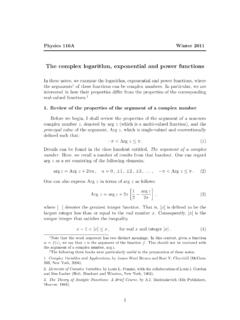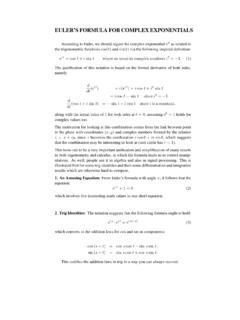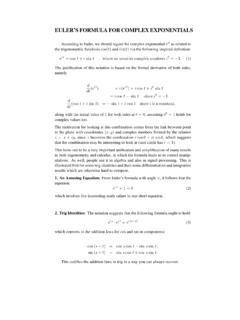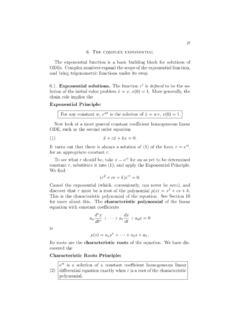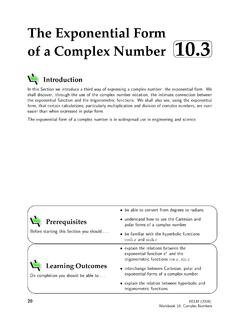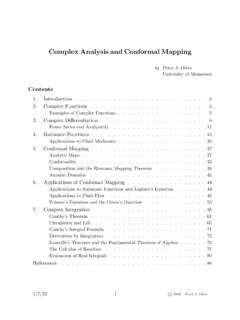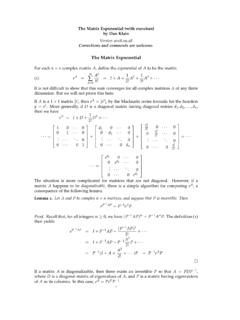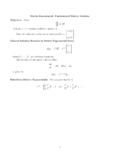Transcription of Introduction to Complex Fourier Series - Nathan Pflueger
1 Introduction to Complex Fourier SeriesNathan Pflueger1 December 2014 Fourier Series come in two flavors. What we have studied so far are calledreal Fourier Series : thesedecompose a given periodic function into terms of the form sin(nx) and cos(nx). This document describesan alternative, where a function is instead decomposed into terms of the formeinx. These Series are calledcomplex Fourier Series , since they make use of Complex practice, it is easier to work with the Complex Fourier Series for most of a calculation, and then convertit to a real Fourier Series only at the end. This pattern is very typical of many of the situations where complexnumbers are this document, I will make two significant simplifications, in order to focus on the conceptualpoints and avoid technical baggage.
2 I will focus onfinite Series , finite sums of terms. This are often called trigonometric polynomials in other contexts. I will consider only functions withperiod2 .1 Complex Fourier coefficientsRecall that we begun discussing Fourier Series by attempting to write a given 2 -periodic functionf(x) inthe following form (notation differs from author to author; I am following Stewart s notation here).f(x) =a0+ n=1(ancos(nx) +bnsin(nx))In words, the goal was to breakf(x) into its constituent frequencies. The miracle of Fourier Series isthat as long asf(x) is continuous (or even piecewise-continuous, with some caveats discussed in the Stewarttext), such a decomposition is always possible. The functions sin(nx) and cos(nx) form a sort of periodictable: they are the atoms that all other waves are built out contrast, a Complex Fourier Series aims instead to writef(x) in a Series of the following (x) = n= cneinxThere are some technical points about what this notation means (namely what I mean by a sum thatstarts at ), but I am going to gloss over them since we will focus on the case of finite Series the numberscnarecomplexconstants.
3 They are called thecomplex Fourier coefficientsoff(x). the following (x) = 2e 2ix+ (1 +i)e ix+ 5 + (1 i)eix+ 2e2ixThe Complex Fourier coefficients of this function are just the constants in front of these terms. The onesthat aren t zero are as 2= 2c 1= 1 +ic0= 5c1= 1 ic2= 2 The other Fourier coefficients (cnfor all other values ofn) are all are two primary ways to identify the Complex Fourier By computing an integral similar to the integrals used to find real Fourier By first finding the real Fourier coefficients, and converting the real Fourier Series into a complexFourier our scope is quite narrow in this course, we will focus on the second of these two options, andspecifically on the case where the real Fourier Series is Converting between real and Complex Fourier seriesRecall Euler s formula, which is the basic bridge that connects exponential and trigonometric functions, byway of Complex numbers.
4 It states thateix= cosx+isinx. This formula is probably the most importantequation in all of mathematics. It is often important to notice that whenxis replaced with x, this formulachanges in a simple way. This simply reflects the facts that cos( x) = cosx(cosine is an even function) andsin( x) = sinx(sine is an odd function).eix= cosx+isinx(1)e ix= cosx isinx(2)Together, these two formulas show how a Complex exponential can always be converted to trigonometricfunctions. The following two formulas show that it is also possible to convert the other ix+12eix(3)sinx=i2e ix i2eix(4)Both of these formulas follow from the first two formulas: adding them together yields 2 cosx(anddividing by 2 yields cosxalone), while subtracting the first from the second yields 2isinx(and multiplyingbyi2yields sinxalone).
5 Real to complexThe most straightforward way to convert a real Fourier Series to a Complex Fourier Series is to use formulas3 and 4. First each sine or cosine can be split into two exponential terms, and then the matching terms mustbe collected following examples show how to do this with a finite real Fourier Series (often called a trigonometricpolynomial). the (finite) real Fourier series5 cosx+ 12 sinxto a (finite) Complex Fourier Series . What are the Complex Fourier coefficientscn? formulas 3 and 4 as cosx+ 12 sinx= 5(12e ix+12eix)+ 12(i2e ix i2eix)=52e ix+52eix+ 6ie ix 6ie ix=(52+ 6i)e ix+(52 6i)eixThis last line is the Complex Fourier Series . From it we can directly read off the Complex Fourier coefficients:c 1=52+ 6ic1=52 6icn= 0 for all the (finite) real Fourier series7 + 4 cosx+ 6 sinx 8 sin(2x) + 10 cos(24x)to a (finite) Complex Fourier formulas 3 and 4 as + 4 cosx+ 6 sinx 8 sin(2x) + 10 cos(24x) = 7 + 4(12e ix+12eix)+ 6(i2e ix i2eix) 8(i2e 2ix i2e2ix)+ 10(12e 24ix+12e24ix)= 7 + 2e ix+ 2eix+ 3ie ix 3ieix 4ie 2ix+ 4ie2ix+ 5e 24ix+ 5e24ix= 5e 24ix 4ie 2ix+ (2 + 3i)e ix+7 + (2 3i)eix+ 4ie2ix+ Complex to real: first methodTo convert the other direction, from a Complex Fourier Series to a real Fourier Series , you can use Euler sformula (equations 1 and 2).
6 Similar to before, each exponential term first splits into two trigonometricterms, and then like terms must be collected. The following two examples show how this the (finite) Complex Fourier Series (3 + 4i)e 2ix+ (3 4i)e2ixto a (finite) real Fourier formulas 1 and 2 and collecting like terms:(3 + 4i)e 2ix+ (3 4i)e2ix= (3 + 4i) [cos(2x) isin(2x)] + (3 4i) [cos(2x) +isin(2x)]= (3 + 4i) cos(2x) + (4 3i) sin(2x) + (3 4i) cos(2x) + (4 + 3i) sin(2x)= [(3 + 4i) + (3 4i)] cos(2x) + [(4 3i) + (4 + 3i)] sin(2x)= 6 cos(2x) + 8 sin(2x)Note that in the second line I have used the fact that (3 + 4i)i= 4 + 3iand (3 4i)i= 4 + 3iin findingthe coefficients in front of the sin(2x) the (finite) Complex Fourier series2e 2ix+ (1 +i)e ix+ 5 + (1 i)eix+ 2e2ixto a (finite) real Fourier formulas 1 and 2 and collecting like terms.
7 2e 2ix+ (1 +i)e ix+ 5 + (1 i)eix+ 2e2ix= 2 [cos(2x) isin(2x)] + (1 +i) [cosx isinx]+5 + (1 i) [cosx+isinx] + 2 [cos(2x) +isin(2x)]= 2 cos(2x) 2isin(2x) + (1 +i) cosx+ (1 i) sinx+5 + (1 i) cosx+ (1 +i) sinx+ 2 cos(2x) + 2isin(2x)= 5 + [(1 +i) + (1 i)] cosx+ [(1 i) + (1 +i)] sinx+ [2 + 2] cos(2x) + [ 2i+ 2i] sin(2x)= 5 + 2 cosx+ 2 sinx+ 4 cos(2x)Note that I have used the fact that (1 +i)i= 1 +iand (1 i)i= 1 +iwhen going from the first lineto the second Complex to real: another methodThe process described above (splitting eacheinsusing Euler s formula and collecting sine and cosine terms)can become tedious, especially when there are many terms. One alternative which may be less cumbersometo apply is to instead use formulas 3 and 4 after regrouping the exponential terms in a different way.
8 Thefollowing example illustrates what I the same Complex Fourier Series as in example 2ix+ (1 +i)e ix+ 5 + (1 i)eix+ 2e2ixThis time, instead of splitting the exponential terms immediately, begin by rearranging as 2ix+ (1 +i)e ix+ 5 + (1 i)eix+ 2e2ix= 5 + 1 (e ix+eix)+i (e ix eix)+ 2(e 2ix+e2ix)= 5 + 2 cosx+ 2 sinx+ 4 cos(2x)CThe idea here is to find multiples either ofe inx+einxore inx Conversion formulasAnother way to perform the conversions above is to simply observe the following formulas relating the realFourier coefficients to the Complex Fourier coefficients. I hesitate to worsen the already dense thicket offormulas in this unit of the course, but I will produce the formulas here in case you find them compute Complex coefficients from real coefficients, the following formulas can be (an ibn) (forn 1)c n=12(an+ibn) (forn 1)These formulas are easy to remember as long as you know formulas 3 and 4: simply think about which ofthe termsancos(nx) andbnsin(nx) will end up contributing to which terms in the Complex Fourier compute real coefficients from Complex coefficients, the following formulas can be +c n(forn 1)bn=i(cn c n)5
